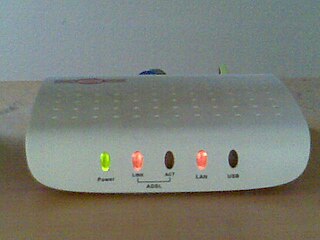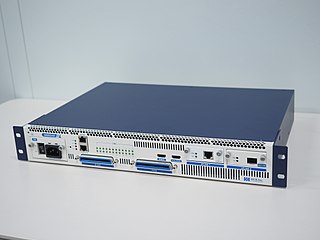Related Research Articles
In telecommunications, orthogonal frequency-division multiplexing (OFDM) is a type of digital transmission and a method of encoding digital data on multiple carrier frequencies. OFDM has developed into a popular scheme for wideband digital communication, used in applications such as digital television and audio broadcasting, DSL internet access, wireless networks, power line networks, and 4G/5G mobile communications.
Digital subscriber line is a family of technologies that are used to transmit digital data over telephone lines. In telecommunications marketing, the term DSL is widely understood to mean asymmetric digital subscriber line (ADSL), the most commonly installed DSL technology, for Internet access.
A symmetric digital subscriber line (SDSL) is a digital subscriber line (DSL) that transmits digital data over the copper wires of the telephone network, where the bandwidth in the downstream direction, from the network to the subscriber, is identical to the bandwidth in the upstream direction, from the subscriber to the network. This symmetric bandwidth can be considered to be the opposite of the asymmetric bandwidth offered by asymmetric digital subscriber line (ADSL) technologies, where the upstream bandwidth is lower than the downstream bandwidth. SDSL is generally marketed at business customers, while ADSL is marketed at private as well as business customers.
Very high-speed digital subscriber line (VDSL) and very high-speed digital subscriber line 2 (VDSL2) are digital subscriber line (DSL) technologies providing data transmission faster than the earlier standards of asymmetric digital subscriber line (ADSL) G.992.1, G.992.3 (ADSL2) and G.992.5 (ADSL2+).

A digital subscriber line access multiplexer is a network device, often located in telephone exchanges, that connects multiple customer digital subscriber line (DSL) interfaces to a high-speed digital communications channel using multiplexing techniques. Its cable internet (DOCSIS) counterpart is the Cable modem termination system.
Data Over Cable Service Interface Specification (DOCSIS) is an international telecommunications standard that permits the addition of high-bandwidth data transfer to an existing cable television (CATV) system. It is used by many cable television operators to provide cable Internet access over their existing hybrid fiber-coaxial (HFC) infrastructure.
In telecommunications, ITU-T G.992.1 is an ITU standard for ADSL using discrete multitone modulation (DMT). G.dmt full-rate ADSL expands the usable bandwidth of existing copper telephone lines, delivering high-speed data communications at rates up to 8 Mbit/s downstream and 1.3 Mbit/s upstream.
ANSI T1.413 is a technical standard that defines the requirements for the single asymmetric digital subscriber line (ADSL) for the interface between the telecommunications network and the customer installation in terms of their interaction and electrical characteristics. ADSL allows the provision of voiceband services including plain old telephone service (POTS) and data services up to 56 kbit/s, and a variety of digital channels. In the direction from the network to the customer premises (downstream), the digital bearer channels may consist of full-duplex low-speed bearer channels and simpler high-speed bearer channels; in the other (upstream) direction, only low-speed bearer channels are provided.

G.992.5 is an ITU-T standard for asymmetric digital subscriber line (ADSL) broadband Internet access. The standard has a maximum theoretical downstream sync speed of 24 megabits per second (Mbit/s). Utilizing G.992.5 Annex M upstream sync speeds of 3.3 Mbit/s can be achieved.
Carrierless amplitude phase modulation (CAP) is a variant of quadrature amplitude modulation (QAM). Instead of modulating the amplitude of two carrier waves, CAP generates a QAM signal by combining two PAM signals filtered through two filters designed so that their impulse responses form a Hilbert pair. If the impulse responses of the two filters are chosen as sine and a cosine, the only mathematical difference between QAM and CAP waveforms is that the phase of the carrier is reset at the beginning of each symbol. If the carrier frequency and symbol rates are similar, the main advantage of CAP over QAM is simpler implementation. The modulation of the baseband signal with the quadrature carriers is not necessary with CAP, because it is part of the transmit pulse.

ITU G.992.3 is an ITU standard, also referred to as ADSL2 or G.dmt.bis. It optionally extends the capability of basic ADSL in data rates to 12 Mbit/s downstream and, depending on Annex version, up to 3.5 Mbit/s upstream. ADSL2 uses the same bandwidth as ADSL but achieves higher throughput via improved modulation techniques. Actual speeds may decrease depending on line quality; usually the most significant factor in line quality is the distance from the DSLAM to the customer's equipment.

A digital subscriber line (DSL) modem is a device used to connect a computer or router to a telephone line which provides the digital subscriber line (DSL) service for connection to the Internet, which is often called DSL broadband. The modem connects to a single computer or router, through an Ethernet port, USB port, or is installed in a computer PCI slot.
Uni-DSL (UDSL) is a digital subscriber line (DSL) marketing buzzword developed by Texas Instruments which would provide bit rates of at least 200 Mbit/s in aggregate on the downstream and upstream paths. UDSL is backwards compatible with all discrete multitone modulation (DMT) standards.
High-bit-rate digital subscriber line 2 (HDSL2) is a standard developed by the American National Standards Institute (ANSI) Committee T1E1.4 and published in 2000 as ANSI T1.418-2000. Like its predecessor HDSL, HDSL2 provides a symmetric data rate of 1,544 kbit/s in both the upstream and downstream directions at a noise margin of 5-6 dB. Its primary purpose was also to provision a T-1 line, only this technology relies on fewer wires - two instead of four - and therefore costs less to set up. The modulation technique used in HDSL2 is TC-PAM, which is also used in G.SHDSL, as opposed to 2B1Q in HDSL. Spectral shaping is applied to increase compatibility with ADSL and HDSL2 on the same bundle. HDSL4 provides the same bitrate as HDSL2, but uses four wires instead of two, to increase robustness. On an AWG26 local loop, the reach of HDSL2 is 9,000 feet (2.7 km), while that of HDSL4 is 11,000 feet (3.4 km).
Ethernet in the first mile (EFM) refers to using one of the Ethernet family of computer network technologies between a telecommunications company and a customer's premises. From the customer's point of view, it is their first mile, although from the access network's point of view it is known as the last mile.
High-bit-rate digital subscriber line (HDSL) is a telecommunications protocol standardized in 1994. It was the first digital subscriber line (DSL) technology to use a higher frequency spectrum over copper, twisted pair cables. HDSL was developed to transport DS1 services at 1.544 Mbit/s and 2.048 Mbit/s over telephone local loops without a need for repeaters. Successor technology to HDSL includes HDSL2 and HDSL4, proprietary SDSL, and G.SHDSL.
The prevalent means of connecting to the Internet in Germany is DSL, introduced by Deutsche Telekom in 1999. Other technologies such as Cable, FTTH and FTTB (fiber), Satellite, UMTS/HSDPA (mobile) and LTE are available as alternatives.

Asymmetric digital subscriber line (ADSL) is a type of digital subscriber line (DSL) technology, a data communications technology that enables faster data transmission over copper telephone lines than a conventional voiceband modem can provide. ADSL differs from the less common symmetric digital subscriber line (SDSL). In ADSL, bandwidth and bit rate are said to be asymmetric, meaning greater toward the customer premises (downstream) than the reverse (upstream). Providers usually market ADSL as an Internet access service primarily for downloading content from the Internet, but not for serving content accessed by others.

John Mathew Cioffi is an American electrical engineer, educator and inventor who has made contributions in telecommunication system theory, specifically in coding theory and information theory. Best known as "the father of DSL," Cioffi's pioneering research was instrumental in making digital subscriber line (DSL) technology practical and has led to over 400 publications and more than 100 pending or issued patents, many of which are licensed.

G.fast is a digital subscriber line (DSL) protocol standard for local loops shorter than 500 meters, with performance targets between 100 Mbit/s and 1 Gbit/s, depending on loop length. High speeds are only achieved over very short loops. Although G.fast was initially designed for loops shorter than 250 meters, Sckipio in early 2015 demonstrated G.fast delivering speeds over 100 Mbit/s at nearly 500 meters and the EU announced a research project.
References
- 1 2 3 4 5 6 Vladimir Oksman (2 August 2004). "Fundamentals of Single-Carrier Modulation". In Philip Golden; Hervé Dedieu; Krista S. Jacobsen (eds.). Fundamentals of DSL Technology. CRC Press. p. 144. ISBN 978-0-203-31749-5.
- ↑ "GlobeSpan Emerges From the Former AT&T Paradyne as a Separate Technology Licensing Business". PR Newswire. 1996-08-20. Retrieved 2014-03-06.
- ↑ "AT&T Paradyne Announces High-Speed Modem Technology". New York Times. 1996-06-04. Retrieved 2014-03-06.
- ↑ "T1.TR.59-1999 - Single-Carrier Rate Adaptive Digital Subscriber Line (RADSL)". ANSI. September 1999. Retrieved 2014-03-06.
- 1 2 3 4 5 "Technical Report No. 59 - Single-Carrier Rate Adaptive Digital Subscriber Line (RADSL)" (PDF). ANSI. September 1999. Retrieved 2014-03-06.
- ↑ "TR-197 - DQS: DSL Quality Management Techniques and Nomenclature" (PDF). Broadband Forum. August 2012. p. 29–30. Retrieved 2014-03-06.
- ↑ "5.4.2.2.2 Link Initialization and Adaptation" (PDF). Technical Report No. 59 - Single-Carrier Rate Adaptive Digital Subscriber Line (RADSL). ANSI. September 1999. p. 104–105. Retrieved 2014-03-06.